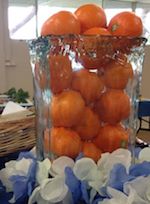Ostriches & Zulus - President's Message 23/09
22/09/2016 11:02:40 PM
| Author | |
| Date Added | |
| Automatically create summary | |
| Summary |
My daughter-in-law, Matti Gild, was born in Cape Town, left when she was two years old and grew up in St Ives. Matti and my son Adam, together with their daughter Claudia and the machatunim, Lesley and Bernard Gild, went for a holiday to Cape Town in early 2013 and raved about how great it was. So my wife Yvonne and I went ourselves this past January and also had a wonderful time. One of the highlights was a Friday night that we spent with Matti’s aunt and uncle, Patsy and Les Marcow, who live in Sea Point in Cape Town. We went to the Marais Road Shul (also called the Green and Sea Point Hebrew Congregation), where Les had been president for many years; he is still active and has the title of “Trustee.” Les told us that, as it was the middle of the holidays, the shul would be very quiet. It was not. There were about 250 men and over100 women – and the majority were at shul before the start of Mincha! Because I was sitting next to Les, a good hundred men came by to shake my hand and wish me Good Shabbos. Although the rabbi was away on holiday, the services were good, led by Chazzan Ivor Joffe and a big choir (12 men). What a warm and impressive Jewish community!
We drove east to the Garden Route via the Klein Karoo (highway route 62), stopping at Oudtshoorn, the ostrich capital of the world and once the home of so many Jews that it was called the “Jerusalem of Africa.” Ostrich feathers came into fashion in the 1870s and Jews, mainly from Lithuania, came to the area, working as farmers and merchants. They formed a synagogue in 1888; most of them came from a shtetl called Shavel, but the rabbi and some congregants had spent time in London, so it was called “Der Englishe Shul.” Other Jews came from another shtetl, Kelme, who were more religious and split away in 1892 to form their own congregation, called the “Griener Shul” (i.e., the newcomers). At its peak in the early 1900s, Oudtshoorn had 1500 Jews out of a population of less than 10,000. The ostrich industry collapsed at the beginning of the First World War and most of the Jews left. The original synagogue is still there, used for the occasional simchah when a rabbi comes from Cape Town or Johannesburg – there are 16 Jewish families still living in the area. The interiors of second synagogue are fully preserved in the main museum in town.
The Australian Jewish community has been enriched and enlivened by the large influx of South Africans over the past 30-40 years. Our own synagogue has grown and prospered – one-time South African Jews and their families make up about half of our kehillah. As I wrote last week, this Shabbos we are honouring two of our communal leaders, Malcolm Kofsky and Ian Charif, both South Africans who have served as president and other positions in our synagogue. There will be a special Kiddush, called “there‘s a zulu on my stoep,” where we will be serving biltong, pareve melktart, boerewors and pap and other South African goodies – thanks to Ian and Bernice Charif and their family for organising the l’chaim, including much of the food preparation. We plan to devote this year’s Shabbat Project in November to the link between the Jews in South Africa and Australia. We celebrate the Jewish South African history and their strong presence here.
Mon, 25 August 2025
1 Elul 5785
Contact Us:
Today's Calendar
| Rosh Chodesh Elul |
| Shacharis : 6:30am |
: 9:10am |
: 5:30pm |
| Mincha : 5:35pm |
: 5:57pm |
This week's Torah portion is Parshas Shoftim
| Shabbos, Aug 30 |
Candle Lighting
| Friday, Aug 29, 5:17pm |
Havdalah
| Motzei Shabbos, Aug 30, 6:13pm |
Rosh Chodesh Elul
| Monday, Aug 25 |
Full Calendar Here
Happy Jewish Birthday!
Monday 1 Elul
- Toby Levine-Evans
We wish "Long Life" to:
Monday 1 Elul
- Elaine Bolon for father, Gerald Sender
Wednesday 3 Elul
- Cecille Levin for husband, Gerald Philip Levin
- Gary Weiss for uncle, Berl Yisosko Dov Frankl
Halachik Times
| Alos Hashachar | 5:09am |
| Earliest Tallis | 5:38am |
| Netz (Sunrise) | 6:23am |
| Latest Shema | 9:10am |
| Zman Tefillah | 10:06am |
| Chatzos (Midday) | 11:58am |
| Mincha Gedola | 12:25pm |
| Mincha Ketana | 3:13pm |
| Plag HaMincha | 4:22pm |
| Shkiah (Sunset) | 5:32pm |
| Tzais Hakochavim | 5:57pm |
| More >> | |
South Head Catering

South Head Catering is well and truly on the map! What began as a small initiative to provide a little variety and some new options by the South Head Ladies Guild has turned into a highly successful venture with people absolutely raving about the service and products on offer.
Want to know more? Want to help out and volunteer? Visit our Catering page.
Mikvah Aziza
Mikvah Aziza at 662 Old South Head Road, Rose Bay has re-opened.
Please click here for details:
South Head Library
 Welcome to the Sandra Bransky Library & Youth Synagogue, located on the first floor and including the Beit Midrash. Drop in any Sunday morning between 9 - 11am.
Welcome to the Sandra Bransky Library & Youth Synagogue, located on the first floor and including the Beit Midrash. Drop in any Sunday morning between 9 - 11am.
I look forward to helping you get the most out of our beautiful world of books at South Head.
Sylvia Tuback, South Head Libarian
southheadlibrary@gmail.com
SHOFTIM
Rose Bay, NSW 2029
(02) 9371 7300
Privacy Settings | Privacy Policy | Member Terms
©2025 All rights reserved. Find out more about ShulCloud



